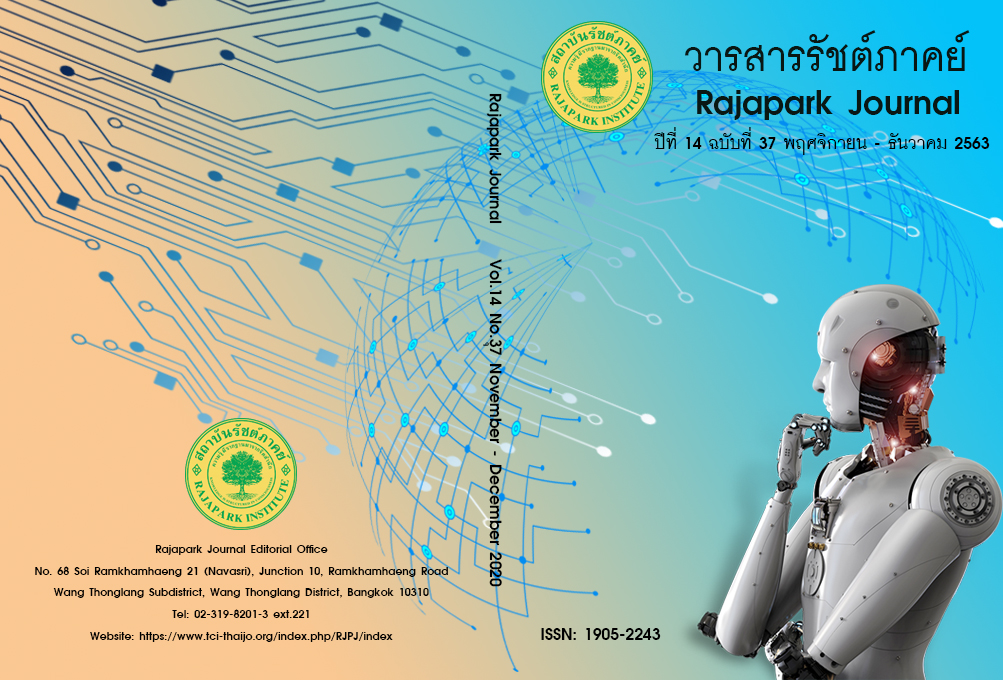Factors Affecting the Acceptance of “Block chain” Technology in Schools
Main Article Content
Abstract
The purposes of this study were to examine the factors that affect the acceptance of the “Block chain” technology and to develop the factors affecting the acceptance of the “Block chain” technology in schools. The study was a quantitative research. The population was a staff using the Block chain technology program in schools, which was unable to know the exact population Yamane's (1973) prefabricated sample table was assigned to 400 people. The results of the study showed that the factors affecting the acceptance of using the Block Chain technology consisting of Safety, Efficient Usage, Technology Expectation with statistically significant at 0.05 level. The new knowledge found was the opinions of users of blockchain software packages on the adoption of blockchain technology, and the factors studied have been found to influence the adoption of blockchain technology was a new story that has changed the way of working was a pattern to do transactions without intermediaries. There was an operating system that communicates to users directly and instantly, and has a secure verification system with a trading platform the on-device database management process is open to everyone. And have specific rights and can take advantage of the distributed system to benefit with various departments and educational institutions that can apply the information.
Article Details
Views and opinions appearing in the Journal it is the responsibility of the author of the article, and does not constitute the view and responsibility of the editorial team.
References
Achavanantakun, S. (2016). Blockchain: The Technology a revolution to society. Retrieved March 20, 2020, from https://thaipublica.org/2016/07/blockchain-revolution/
Chaveesuk, S., & Vongjaturapat, S. (2012). Theory of Information Technology Adoption. KMITL Information Technology Journal, 1(1). 1-21.
Davis, F. D. (1989). Perceived Usefulness, Perceived Ease of Use, and User Acceptance of Information Technology. MIS Quarterly, 13(3), 319-339.
Hannongbua, S. (2016). Learning Management Education 4.0 No.1. Documentation for Learning Management Education 4.0, At Rajanagarindra Meeting Room, 5th Floor, 100 Years Building, Valaya Alongkorn Rajabhat University Under the Royal Patronage. June 2, 2016.
Heinich, R., Molenda, M., & Russell, J. D. (1992). Instructional Media and The New Technologies of Instruction (4th ed.). New York: Macmillan Publishing Company.
Malisuwan, S. (2017). 90% of Startups Fail: and 10% are successful. What do they do?. Retrieved March 25, 2020, from https://www.it24hrs.com/2017/startup-someone-success/
Ploywattanawong, L., & Boonkrong, S. (2018) Bitcoin & Blockchain Technology. KKU RESEARCH JOURNAL (GRADUATE STUDIES), 18(1), 1-12.
Prentice-Dunn, S., & Rogers, R. W. (1986). Protection Motivation Theory and preventive health: Beyond the Health Belief Model. Health Education Research, 1(3), 153–161. https://doi.org/10.1093/her/1.3.153
Satchakorn, S. (2003). Excellent reception and service. Bangkok: Stream.
Schwab, K. (2015). The Global Competitiveness Report 2015–2016. Retrieved March 25, 2020, from http://www3.weforum.org/docs/gcr/2015-2016/Global_Competitiveness_Report_2015-2016.pdf
Sinlarat, P. et al. (2016). Education 4.0 is more than education (2nd ed.). Bangkok: ChulalongkornUniversity Printing House.
Tanacharoenpisarn, E. (2011). Personnel's Awareness and Acceptance on Implementation of Environmental Management System (ISO 14001) in Public Organization: a case study of Office of Natural Resources and Environmental Policy and Planning. Master of Science (Environmental Management), National Institute of Development Administration.
Yamane, T. (1973). Statistics: An Introductory Analysis (3rd ed.). New York: Harper and Row.


